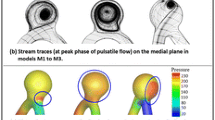Summary
The flow pattern and the paths of fluid particles in a saccular aneurysm located at the bifurcation of an intracranial arterial segment are investigated with a numerical method. A normal physiological flow pattern was assumed as imput to the studied segment. The theoretical study is carried out for two different Reynolds numbers and two different geometries of the aneurysm. The governing equations for incompressible Newtonian fluid flow are solved using the finite element method. The results show the disturbed blood flow in the pathologically altered bifurcation and the flow activity in the aneurysms. It is particularly important that blood particles can circulate in a whirl within the aneurysm for a time which seems long enough to permit the generation of cell aggregates or/and blood clots.
Similar content being viewed by others
References
Bharadvaj BK, Mabon RF, Giddens DP (1982) Steady flow in a model of the human carotid bifurcation. Part I — Flow visualization. J Biomech 15: 349–362
Ferguson GG, Roach MR (1972) Physical factors in the initiation, growth and rupture of human intracranial aneurysms. J Neurosurg 37:666–677
Florian H, Perktold K, Gruber K (1984) Simulation der Partikelbahnen im pulsierenden Blutstrom einer Carotisverzweigung. Österr Akad Math Naturwiss Kl Bd 193:105–113
Hilbert D. (in press) An efficient Navier-Stokes solver and its application to fluid flow in elastic tubes. Colloquia Mathematica Societatis Janos Bolyai, North-Holland
Nimpf J, Wurm H, Kostner GM, Kenner T (1987) Platelet activation in normo-and hyperlipo-proteinemias. Basic Res Cardiol 81:437–453
Perktold K (1985) Numerische Lösung des instationären dreidimensionalen Navier-Stokes-Problems Ber Math-Stat Sektion Forsch Graz, Nr. 255, Graz
Perktold K, Florian H, Hilbert D (1987) Analysis of pulsatile blood flow: A carotid siphon model. J Biomed Eng 9:46–53
Perktold K, Hilbert D (1986) Numerical simulation of pulsatile flow in a carotid bifurcation model. J Biomed Eng 8:193–199
Roach MR (1977) The effect of bifurcation and stenosis on arterial diseases.In: Hwang NHC, Normann NA (eds), Cardiovascular Flow Dynamics and Measurements. Univ Park Press, Baltimore London Tokyo, pp 489–539
Author information
Authors and Affiliations
Additional information
Supported by the Austrian Research Fund (Fonds zur Förderung der wissenschaftlichen Forschung in Österreich), Projekt-Nr. P 5954 P, Vienna, Austria
Rights and permissions
About this article
Cite this article
Perktold, K., Kenner, T., Hilbert, D. et al. Numerical blood flow analysis: Arterial bifurcation with a saccular aneurysm. Basic Res Cardiol 83, 24–31 (1988). https://doi.org/10.1007/BF01907101
Received:
Issue Date:
DOI: https://doi.org/10.1007/BF01907101




